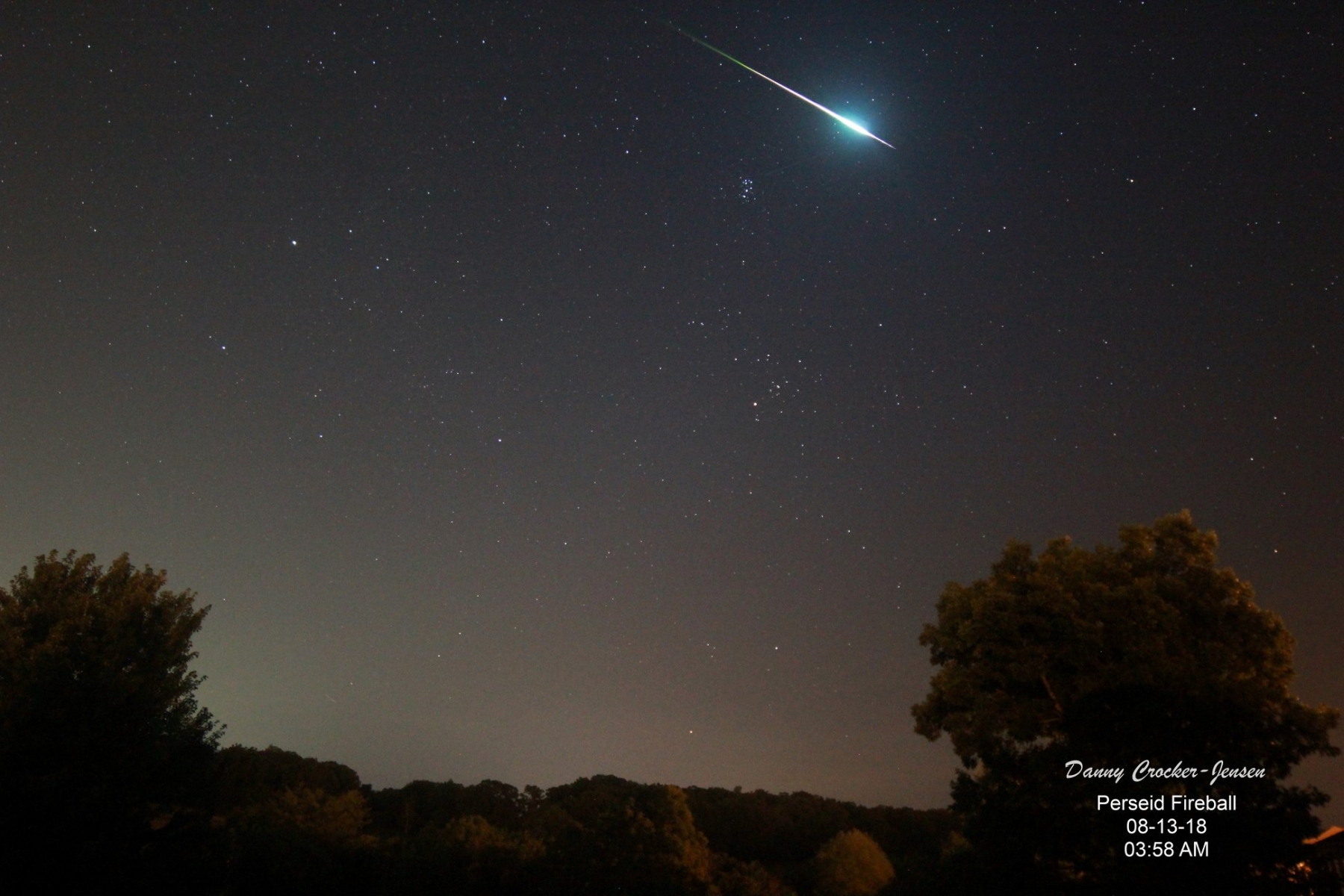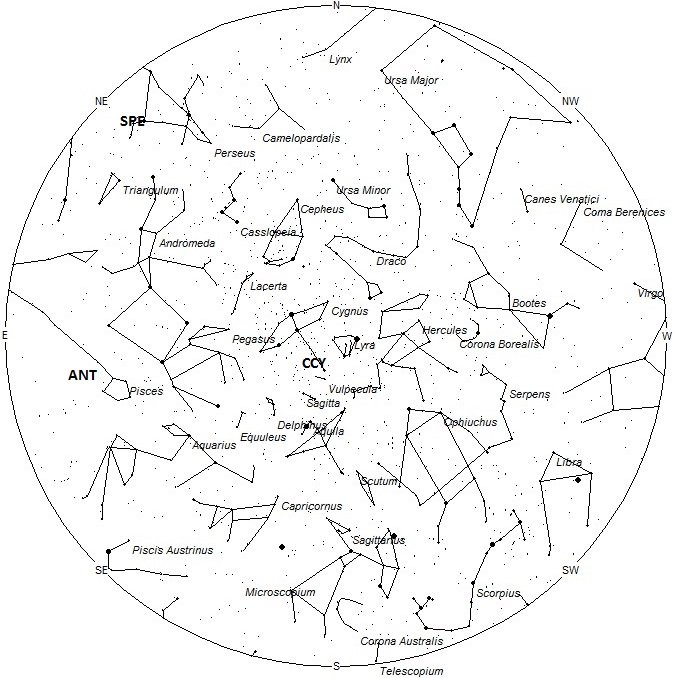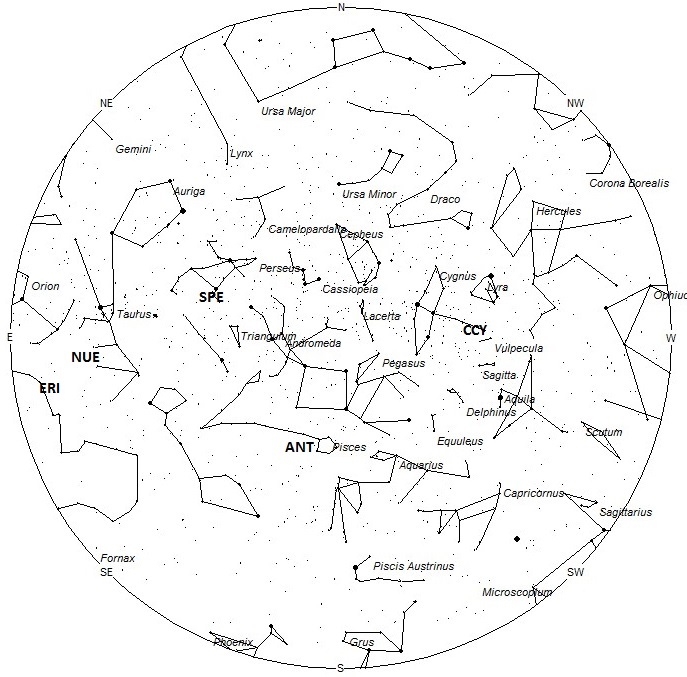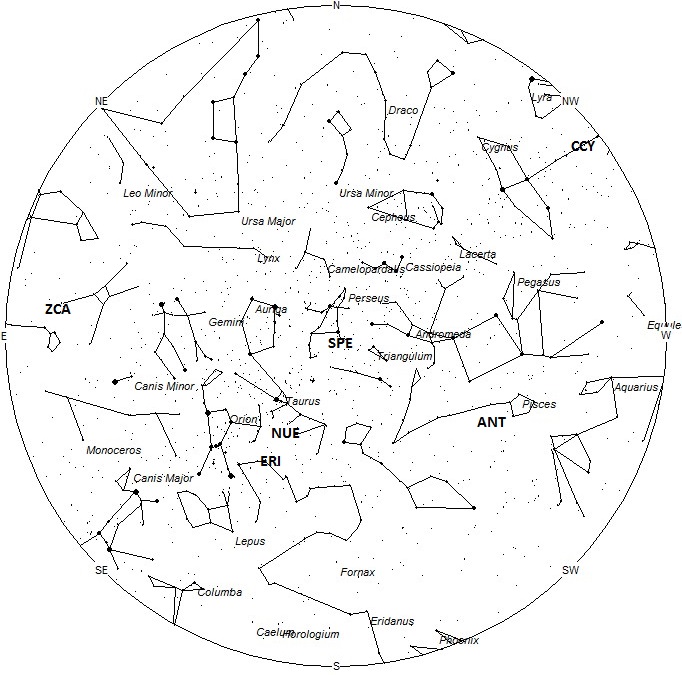
During this period the moon will reach its new phase on Sunday September 9th. At that time the moon will lie near the sun in the sky and will be invisible at night. As the week progresses the waxing crescent moon will enter the evening sky but will not interfere with viewing meteor activity. The estimated total hourly meteor rates for evening observers this week is near 4 as seen from mid-northern latitudes and also 3 for those viewing from subtropical southern latitudes (25S). For morning observers the estimated total hourly rates should be near 16 for those viewing from mid-northern latitudes and 10 for those viewing from subtropical southern latitudes (25S). The actual rates will also depend on factors such as personal light and motion perception, local weather conditions, alertness and experience in watching meteor activity. Note that the hourly rates listed below are estimates as viewed from dark sky sites away from urban light sources. Observers viewing from urban areas will see less activity as only the brighter meteors will be visible from such locations.
The radiant (the area of the sky where meteors appear to shoot from) positions and rates listed below are exact for Saturday night/Sunday morning September 8/9. These positions do not change greatly day to day so the listed coordinates may be used during this entire period. Most star atlases (available at science stores and planetariums) will provide maps with grid lines of the celestial coordinates so that you may find out exactly where these positions are located in the sky. A planisphere or computer planetarium program is also useful in showing the sky at any time of night on any date of the year. Activity from each radiant is best seen when it is positioned highest in the sky, either due north or south along the meridian, depending on your latitude. It must be remembered that meteor activity is rarely seen at the radiant position. Rather they shoot outwards from the radiant so it is best to center your field of view so that the radiant lies near the edge and not the center. Viewing there will allow you to easily trace the path of each meteor back to the radiant (if it is a shower member) or in another direction if it is a sporadic. Meteor activity is not seen from radiants that are located far below the horizon. The positions below are listed in a west to east manner in order of right ascension (celestial longitude). The positions listed first are located further west therefore are accessible earlier in the night while those listed further down the list rise later in the night.
These sources of meteoric activity are expected to be active this week.
The chi Cygnids (CCY) are a new discovery due to an outburst observed on September 15, 2015. These meteors are expected to be active from September 8-17, with maximum occurring on September 13-14. The radiant currently lies at 19:48 (297) +30 which places it in southern Cygnus, 4 degrees northeast of the famous 3rd magnitude double star known as Albireo (beta Cygnus). Rates are expected to be low except at maximum when perhaps 1 shower member per hour may be seen. This radiant is best near 22:00 (10pm LDT) when it lies highest in the sky. With an entry velocity of 15 km/sec., the average chi Cygnid meteor would be very slow.
The center of the large Anthelion (ANT) radiant is currently located at 23:56 (359) -00. This position lies in western Pisces, 7 degrees south of the 4th magnitude star known as omega Piscium. Due to the large size of this radiant, Anthelion activity may also appear from eastern Aquarius and northwestern Cetus as well as Pisces. This radiant is best placed near 0200 LDT, when it lies on the meridian and is located highest in the sky. Hourly rates at this time should be near 2 no matter your location. With an entry velocity of 30 km/sec., the average Anthelion meteor would be of medium-slow velocity.
The September Epsilon Perseids (SPE) are active from September 3 through October 3 with the peak occurring on the night of September 10/11. The radiant is currently located at 03:06 (047) +39. This position lies just 2 degrees south of the variable star known as Algol (beta Persei). The radiant is best placed near 0500 LDT, when it lies highest above the horizon. Rates are expected to be near 2 per hour as seen from the northern hemisphere and less than 1 as seen from the southern hemisphere. With an entry velocity of 65 km/sec., most activity from this radiant would be swift.
The nu Eridanids (NUE) were co-discovered by Japanese observers using SonotoCo and Juergen Rendtel and Sirko Molau of the IMO. Activity from this long-period stream stretches from August 24 all the way to November 16. Maximum activity occurs on September 24th. The radiant currently lies at 04:12 (063) +04, which places it in southern Taurus, 3 degrees southeast of the 4th magnitude star known as nu Tauri. This area of the sky is best seen during the last dark hour before dawn when the radiant lies highest in a dark sky. Current rates are expected to be near 1 per hour during this period no matter your location. With an entry velocity of 67 km/sec., the average meteor from this source would be of swift velocity.
The eta Eridanids (ERI) were discovered by Japanese observers back in 2001. Activity from this stream is seen from July 23 though September 17 with maximum activity occurring on August 11. The radiant currently lies at 04:36 (069) -04, which places it in northeastern Eridanus, 2 degrees west of the magnitude star known as nu Eridani. This area of the sky is best seen during the last dark hour before dawn when the radiant lies highest in a dark sky. Current rates are expected to be less than 1 per hour during this period no matter your location. With an entry velocity of 65 km/sec., the average meteor from this source would be of swift velocity.
The last of the Daytime zeta Cancrids (ZCA) should be visible this weekend. This stream is active from August 13 through September 10 with maximum activity occurring on September 3rd. The radiant is currently located at 09:26 (142) +11, which places it in southeastern Cancer, just south of the 4th magnitude star known as Acubens (alpha Cancri). This area of the sky is located only 30 degrees west of the sun so any possibility of seeing these meteors would be limited to the time just before the start of morning twilight. Current rates are expected to be less 1 per hour no matter your location. With an entry velocity of 42 km/sec., the average meteor from this source would be of medium velocity.
As seen from the mid-northern hemisphere (45N) one would expect to see approximately 11 sporadic meteors per hour during the last hour before dawn as seen from rural observing sites. Evening rates would be near 3 per hour. As seen from the tropical southern latitudes (25S), morning rates would be near 7 per hour as seen from rural observing sites and 2 per hour during the evening hours. Locations between these two extremes would see activity between the listed figures.
The list below offers the information from above in tabular form. Rates and positions are exact for Saturday night/Sunday morning except where noted in the shower descriptions.
| SHOWER | DATE OF MAXIMUM ACTIVITY | CELESTIAL POSITION | ENTRY VELOCITY | CULMINATION | HOURLY RATE | CLASS |
| RA (RA in Deg.) DEC | Km/Sec | Local Daylight Saving Time | North-South | |||
| chi Cygnids (CCY) | Sept 13-14 | 19:48 (297) +30 | 15 | 22:00 | <1 – <1 | IV |
| Anthelions (ANT) | – | 23:56 (359) -00 | 30 | 02:00 | 2 – 2 | II |
| September Epsilon Perseids (SPE) | Sep 11 | 03:06 (047) +39 | 65 | 06:00 | 2 – <1 | II |
| nu Eridanids (NUE) | Sep 24 | 04:12 (063) +04 | 67 | 07:00 | 1 – 1 | IV |
| eta Eridanids (ERI) | Aug 11 | 04:36 (069) -04 | 65 | 07:00 | <1 – <1 | IV |
| Daytime zeta Cancrids (ZCA) | Sep 03 | 09:26 (142) +11 | 42 | 12:00 | <1 – <1 | IV |
 American Meteor Society
American Meteor Society



so where can i see this? every time there is a shower no information is given to the location or locations i can see them. You provide no map of the USA that shows hot spots or anything close to that. you dont provide est time or central or mountin like the information is bery vauge. can you please provide this in the future. a US map to show us where they will be would be very helpful. thank you
Hi Jason and All,
This information is valid from nearly every location so use it as if was written for your location. You can see meteor activity from anywhere you can see the stars. The darker the sky, the more meteor activity you will see. The times are the same too so if it says these meteors can be best seen near 1am local time that means 1am no matter which time zone you inhabit.
I hope this helps…
I saw an amazing, long lasting (5 to 6 sec) meteor at 04:21 this morning. I’m in Atlanta, GA and it was moving west to east and traversed my whole field of vision (aprox. 120 degrees) Very yellow\orange color)
I live in GA and I saw I am pretty sure a meteor streak across the sky around 4:20 am on 9/10/2018. I have never witnessed anything like this in person before. It was really cool. It was a fireball with a long tail moving incredibly fast before it finally fizzled out. Even though it looked like it was pretty low in the sky I am sure that it was much higher up.
I saw metor last night September 10th at about 11 pm coming from south west to north east didn’t seem very fast compared to others I have seen but seem bigger and brighter I’m in Clare Michigan wonderd if anyone else saw it ?
I too believe I saw a meteor cross from north toward the south out over the ocean east of Boston.
It was moving way too quickly to have been a plane and it had a bright red tail which changed to green then disappeared.
It lasted approximately 5 seconds.
Me and a bus driver saw one in Halifax around 10:00 pm on September 13th… A slow moving 5 second long asleep at the wheel meteor lol.